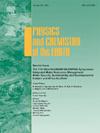威宁平原地下水水质水文地球化学特征
IF 4.1
3区 地球科学
Q2 GEOSCIENCES, MULTIDISCIPLINARY
引用次数: 0
摘要
威宁平原严重依赖地下水来维持人类的生计和经济发展。研究了威宁平原地下水的水化学特征,利用多元统计和图解方法分析了控制地下水水质变化的过程,并通过水文地球化学模拟量化了水岩相互作用对水化学演化的影响程度。结果表明:威宁平原地下水主要成分的浓度顺序为:阳离子中Na+>;Ca2+>Mg2+>K+,阴离子中HCO3−>;SO42−>Cl−>CO32−,水化学类型主要分为SO4·Cl - ca·Mg、SO4·Cl - Na和HCO3 - ca·Mg。此外,该地区硝酸盐污染严重,大部分地下水达不到饮用水标准。主成分分析表明,自然因素和人类活动的结合对确定该地区地下水质量产生了影响。水岩过程是主要的自然控制因素,加上浅层地下水蒸发作用强,显著调节地下水化学变化,而人类活动加剧了地下水化学退化。PHREEQC水文地球化学模拟结果显示,黄河左岸以钙长石溶蚀为主,溶蚀量为5.32 mmol/L,而右岸以阳离子交换为主,溶蚀量为4.32 mmol/L。岩盐、石膏、钙长石的溶解以及Ca2+向Na+的阳离子交换是驱动研究区内地下水水质变化的关键水文地球化学反应。该研究为该地区地下水资源的管理提供了坚实的科学依据。本文章由计算机程序翻译,如有差异,请以英文原文为准。

Hydrogeochemical characterization of groundwater quality in the Weining Plain, northwest China
The Weining Plain relies heavily on groundwater to support human livelihoods and economic development. This research investigated the hydrochemical characteristics of groundwater in the Weining Plain, analyzed the processes controlling the changes in groundwater quality using multivariate statistics and graphical methods, and quantified the extent of the influence of water-rock interactions on the hydrochemical evolution by means of hydrogeochemical modeling. The results point to that the concentration sequence in which the dominant groundwater constituents in the Weining Plain unfold as follows: Na+>Ca2+>Mg2+>K+ among cations, while HCO3−>SO42−>Cl−>CO32− among anions, with hydrochemical types primarily categorized as SO4·Cl–Ca·Mg, SO4·Cl–Na, and HCO3–Ca·Mg. Also, it revealed severe nitrate pollution in the region, with most groundwater not meeting drinking water standards. Principal component analysis identified that a combination of natural factors and human activities makes a difference in determining the quality of groundwater in the region. The water-rock processes are the primary natural controlling factor, coupled with strong shallow groundwater evaporation, which significantly regulate groundwater chemical changes, while human activities exacerbate groundwater chemistry degradation. Hydrogeochemical modeling of PHREEQC highlights that the dissolution of anorthite dominates the left bank path of the Yellow River with 5.32 mmol/L, whereas the cation exchange is significant in the right bank path, with 4.32 mmol/L of Na+. The dissolution of halite, gypsum, anorthite, coupled with cation exchange from Ca2+ to Na+, are key hydrogeochemical reactions driving changes in groundwater quality within the study region. This study provides a solid scientific basis for the management of groundwater resources in the region.
求助全文
通过发布文献求助,成功后即可免费获取论文全文。
去求助
来源期刊

Physics and Chemistry of the Earth
地学-地球科学综合
CiteScore
5.40
自引率
2.70%
发文量
176
审稿时长
31.6 weeks
期刊介绍:
Physics and Chemistry of the Earth is an international interdisciplinary journal for the rapid publication of collections of refereed communications in separate thematic issues, either stemming from scientific meetings, or, especially compiled for the occasion. There is no restriction on the length of articles published in the journal. Physics and Chemistry of the Earth incorporates the separate Parts A, B and C which existed until the end of 2001.
Please note: the Editors are unable to consider submissions that are not invited or linked to a thematic issue. Please do not submit unsolicited papers.
The journal covers the following subject areas:
-Solid Earth and Geodesy:
(geology, geochemistry, tectonophysics, seismology, volcanology, palaeomagnetism and rock magnetism, electromagnetism and potential fields, marine and environmental geosciences as well as geodesy).
-Hydrology, Oceans and Atmosphere:
(hydrology and water resources research, engineering and management, oceanography and oceanic chemistry, shelf, sea, lake and river sciences, meteorology and atmospheric sciences incl. chemistry as well as climatology and glaciology).
-Solar-Terrestrial and Planetary Science:
(solar, heliospheric and solar-planetary sciences, geology, geophysics and atmospheric sciences of planets, satellites and small bodies as well as cosmochemistry and exobiology).
 求助内容:
求助内容: 应助结果提醒方式:
应助结果提醒方式:


